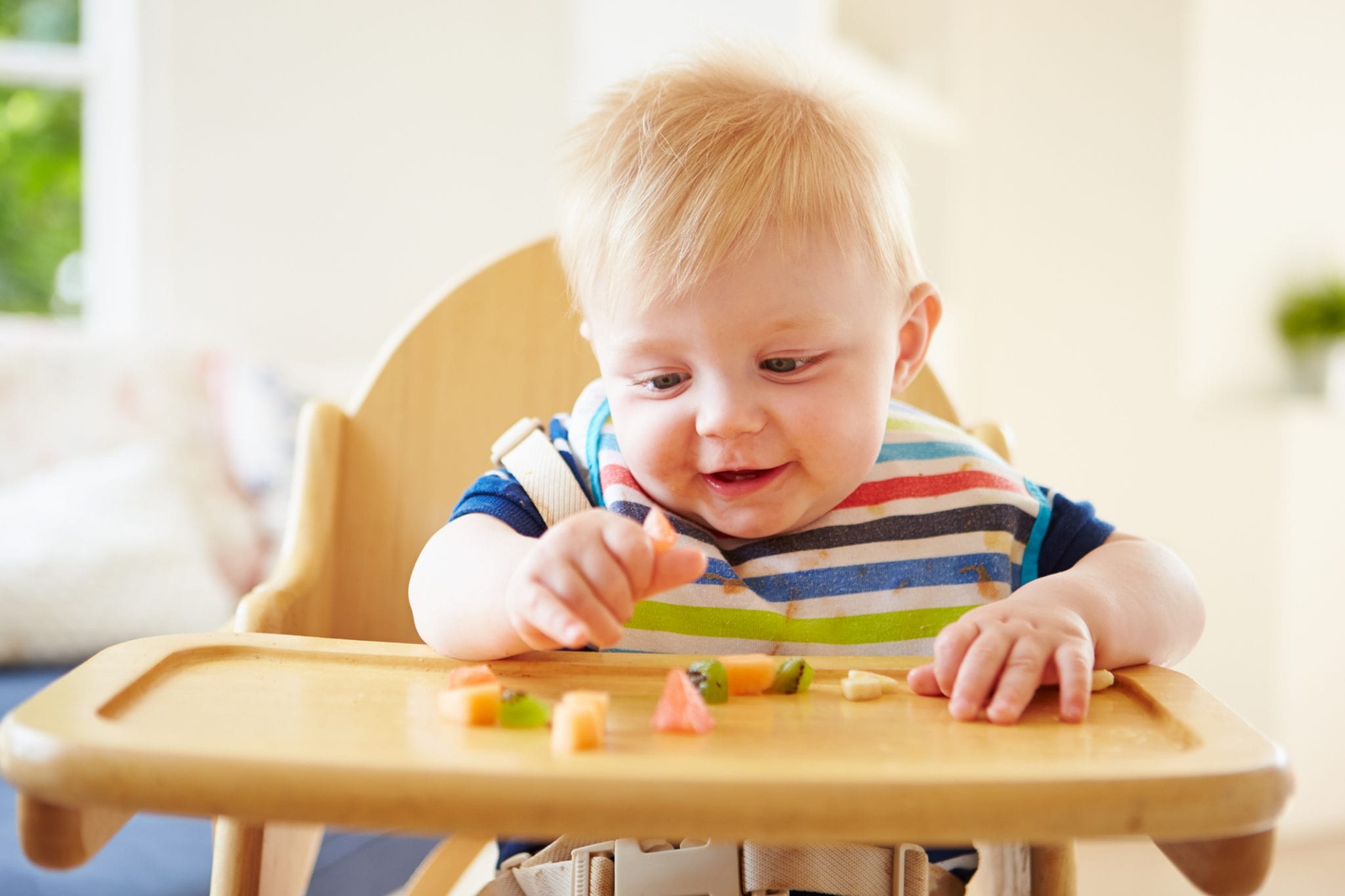Baby-led weaning (BLW) is a gentle, common, and fun way to introduce solids to your baby. While continuing to breastfeed or bottle-feed, babies are allowed and encouraged to feed themselves real, whole foods–when they are ready. Babies have the autonomy to experiment and discover food at their own pace, developing “chewing skills, manual dexterity, and hand-eye coordination” (Rapley & Murkett, xiv). Participating in family meals, they discover a wide range of healthy foods and learn important social skills while choosing what, how much, and how quickly to eat. Babies freely explore various new tastes and textures without pressure to eat a certain amount of food or a specific food.
Baby-led feeding (BLF) may actually be a more appropriate moniker for BLW, as it is about weaning babies onto solids. Even as their diet gradually becomes more varied with complementary solid foods, babies continue to nurse or receive a bottle as often as before. Remember: Solids do not replace milk. Toward the end of the first year (usually 9-12 months), babies gradually increase their solid food intake and decrease their milk intake. By the time they are one year old, the split should be about 50/50. It is a gradual process, led by babies’ innate instincts and abilities.
Baby-Led Weaning and Breastfeeding
According to Rapley & Murkett (2008), because self-feeding is instinctual for babies from birth, breastfeeding is a natural precursor to BLW. Nursing babies are always in control of feeding themselves at the breast, using the mouth’s muscles in a way similar to chewing. Additionally, the flavor of breast milk changes at each feeding based on the mother’s diet, exposing breastfed babies to various tastes from birth (35-37). In fact, this early introduction to flavors often increases babies’ acceptance of foods and eagerness to experiment with them later on. It is important to note that BLW can work just as well for formula-fed babies; due to a lack of exposure to different flavors before starting solids, it may take a bit longer for formula-fed babies to adjust.
Advantages of BLW
BLW has many benefits. If your baby is at least six months old and is ready and eager to begin, he is definitely capable of picking up, holding, chewing, and eating solid foods. It may take him a little while to get comfortable with it, but he can and will! Major advantages of BLW* include:
It’s Fun!
BLW babies look forward to eating. They enjoy learning about different foods, exploring, and doing things for themselves.
It’s Natural
Babies can discover food at their own pace and follow their instincts.
It’s a Learning Experience
Babies learn about the appearance, smell, taste, and texture of different foods and how different flavors combine. They also learn how to eat safely; by feeling pieces of food in their hands and then putting them in their mouth, they learn how to chew and move food around with their tongue. They learn to chew first and then swallow (which is actually safer than the reverse order). By handling food, babies use their senses, learn how to pick up and hold different foods, and explore various sizes, shapes, weights, and textures.
It Helps Babies Reach Their Potential and Gain Confidence
BLW babies get extensive practice with hand-eye coordination, dexterity, chewing, and swallowing. They love the independence of exploring and feeding themselves, which helps them gain confidence in their judgment and abilities.
It Teaches Babies to Trust Food
Because babies are allowed to use their instincts to decide what (and what not) to eat, they rarely show any suspicion of food. They are empowered by knowing that they are in control of what they eat.
It Allows Babies to Participate in Family Mealtimes
Babies can eat the same food as the rest of the family (with some minor modifications) and join in the fun social interaction. Family mealtime also provides ample opportunities to mimic mealtime behavior.
It Promotes Appetite Control, Better Nutrition, and Long-Term Health
Babies are allowed to self-regulate (as they have since birth), stopping when they’re full or continuing when they want more. This teaches them to eat according to their appetite, making them less likely to overeat when they are older. Anecdotal evidence also suggests that BLW babies are less likely to choose unhealthy foods when they are older.
It Allows Babies to Deal With Textures and Learn to Chew
Through practice chewing and moving food around in their mouth, babies quickly learn to manage and enjoy different sizes, shapes, textures, and flavors. Chewing effectively is also good for speech and digestion. Being exposed to diverse foods makes mealtimes more interesting and more inclusive of a wide range of nutrients.
It Provides the Chance to Experience Real Food
Babies can experience some of the real pleasures of eating from the beginning! The individual flavors and textures in a meal elevate the enjoyment of it.
It Helps Babies Develop a Positive Attitude Toward Food
Problems such as food refusal, pickiness, and food phobias are less likely if experiences with food are enjoyable and healthy from the outset. If there is no pressure on babies to eat, mealtimes won’t become a power struggle.
It Is Easier for Everyone
There is no need to purée foods. During meals, parents are free to eat their own food or just enjoy the experience of watching their baby explore. There is no need for games or tricks, and eating out is easy and fun!
Disadvantages of BLW
These aren’t disadvantages, per se, but here are a few potential “negatives”:
It’s Messy
In the beginning, it can be very messy! At my house, a lot of food ended up on the floor for at least the first month–much to our dog’s delight. That phase was quite short, however, as my son quickly honed his eating skills.
Others May Have Concerns
Others may be skeptical or worried about BLW, especially about choking. In my experience, however, once they see it in action, they usually change their mind.
Some Pediatricians Are Uninformed About or Skeptical of BLW
They may discourage you from doing it. My pediatrician, for example, expressed concern about BLW, specifically about choking. While I considered his opinion, I decided to proceed with BLW because I was well informed and prepared from my reading and research. Pediatricians are not nutritionists, and depending on the time and breadth of their training, they may not be current with the newest and best feeding practices. Although there is a lot of new research available about feeding babies, some pediatricians may not be familiar with it or may simply be more traditional. Ultimately, it is up to you to decide what you feel most comfortable with and what you think is best for your baby and family. Inform yourself about the different options and make an educated decision.





















